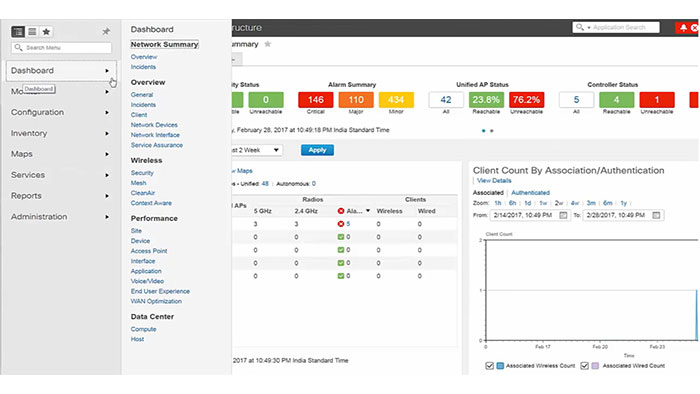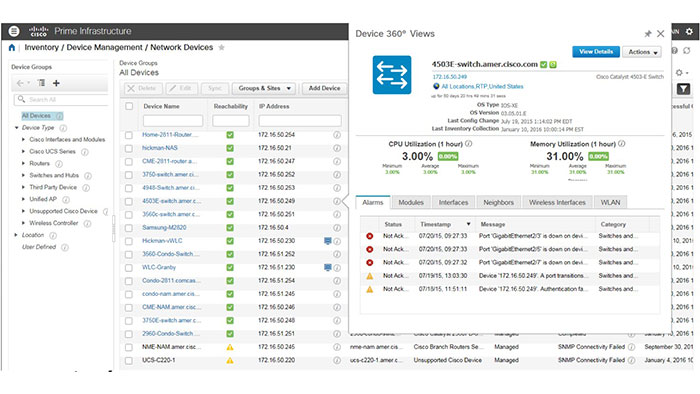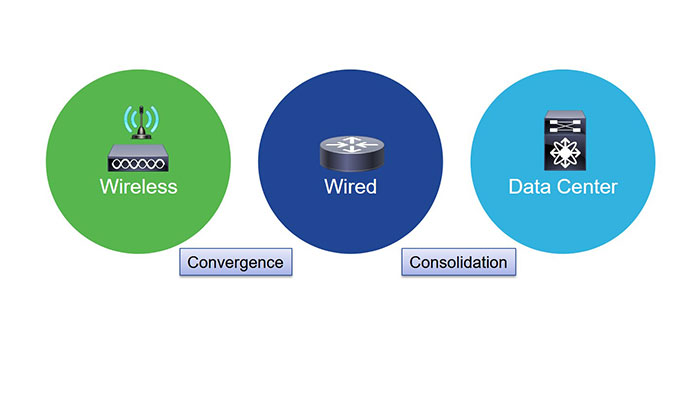
Cisco Prime Infrastructure is a single integrated solution to comprehensively manage the lifecycle of wired and wireless access, campus and branch networks. Cisco Prime Infrastructure provides network administrators with a single solution for provisioning monitoring optimizing and troubleshooting both wired and wireless devices. The different stages of lifecycle approach are design, deploy, operate a report and administer. The Cisco Prime Infrastructure web interface is organized according to the lifecycle workflow which provides an overview of the most important data in your network. This view includes with various dashboards such as Network summary overview, wireless performance and data center. Generally, Cisco Prime is a unified solution for managing every network devices which can be found in Cisco License.
By using the monitor option, you can monitor your network on a daily basis and perform day-to-day or ad-hoc operations relating to network device inventory and configuration management. The monitor option includes dashboards and tools that you need for monitoring, troubleshooting maintenance and operations. Using the configuration option, you can design feature level configuration templates.
If you do not want to use predefined templates you can also create reusable design patterns using the inventory option you can perform device management operations such as adding devices, running discovery, managing software images, configuring device archives and auditing configuration changes on devices using the maps option. Plus, you can view the network topology and wireless maps on Cisco Prime Infrastructure using the services option and you can access mobility services application visibility and control services and intelligent advanced services using the reports option.
Moreover, you can create reports view, saved report templates and run scheduled reports using the administration option. Furthermore, you are able to specify system configuration, settings data collection settings and manage access control. It enables you to view and approve jobs, specify health rules and manage licenses. Finally, you can also perform software updates and configure high availability.
Network monitoring tasks comprise a broad range of activities:
Monitoring the network infrastructure: Are devices and their components running is expected?
Monitoring Network performance: Is network traffic routing for optimal use of resources meeting quality of service agreements?
Monitoring applications: What applications are running on the network? how are they behaving? Monitoring clients and access: Are users able to connect to the network, access the applications that they want and have the experience that they expect?
Monitoring the platform: Is the prime infrastructure server in good health and running optimally?
In fact, monitoring the network involves every aspect of ensuring that the network infrastructure is operating efficiently and is expected. The network can meet user requests and respond to varying demands, and the network meets operational and business requirements. Recognizing the range of Cisco Prime Infrastructure monitoring capabilities, key data analysis tools and the underlying system processes that collect network data will help you manage your monitoring tasks more efficiently and effectively.
Whether you’re monitoring the network infrastructure and its usage client and end-user support or the prime infrastructure system, itself your goal is continuous awareness of how the network is performing and whether there are Network conditions that need attention. Prime Infrastructure provides the features that you need to meet these goals.

From wired and wireless devices on the network to compute devices in the data center, you can monitor at as high or granular a level as you need. Summary views and aggregate data let you see devices in a broader context, or you can access highly detailed device and performance information about network and compute devices down to the component levels, such as wired device details including modules, ports and interfaces. Wireless device details including interfaces clients, mesh and security.
Plus, compute device details including the schematic cluster server and module information. With application visibility and control functionality you’ll have insight into network user activity and the applications that they’re running, and you can track the end-user experience from a summary performance level down to the detailed client and user level, including session details and history, application usage and user identification.
When monitoring Wireless aspects of network operations, you can evaluate such factors as radio frequency or RF interferes and signal coverage problems reported by radio resource management or RRM, context-aware data which reports the location information of mobility assets including rogue devices, clients and tagged assets, and security factors such as top issues, rogue activity and potential attacks.
For all of the performance monitoring aspects of the system from the infrastructure to applications to clients and users Cisco Prime Infrastructure reports faults that might be causing Network impacts. Fault monitoring includes collecting all of the syslog events, SNMP trap events and system generated events that occur based on polling and on reporting thresholds. When condition or series of events require more attention, for example key performance indicator values moving outside of their operational thresholds, the system reports that information in the form of alarms, and just as you monitor network performance and evaluate faults, designated users can perform similar monitoring of the prime infrastructure platform itself including the server, database and API health and statistics.
As the organization expands, you might need to deploy a new branch or new devices on a campus, and you need to perform the ongoing management of device software images to address maintenance releases, security updates or new technologies. Cisco Prime Infrastructure supports these activities by providing device configuration, processes and archiving functions that help ensure flexible and efficient device configuration, while retaining previous configurations for rollback and troubleshooting activities. Automated device deployment that compresses deployment timelines expediting the time it takes for devices or locations to become operational. A straight-forward upgrade process that includes upgrade analysis and image validation before distribution occurs to help avoid disrupting device or network operations.

The configuration archive is an important factor in best practice device management by providing the method by which you can review and compare configuration changes and perform configuration rollback and troubleshooting activities. The configuration archive supports ensuring that network devices are running their correct and optimal configurations.
Cisco Prime Infrastructure automatically collects and archives current device configurations after the device discovery process or after adding new devices to the network. This action ensures that there is an archive available of the current device configuration, and before deploying a new configuration to a device it is an important best practice to archive that device’s current configuration. This way you know that you have a backup in case of a deployment failure.
Then if it becomes necessary you can revert or roll back to the previous operational configuration which helps avoid network disruption, and when you have successfully deployed a new configuration we recommend that you archive the currently running configuration also. This action supports such activities as correcting start up to running configuration mismatches.